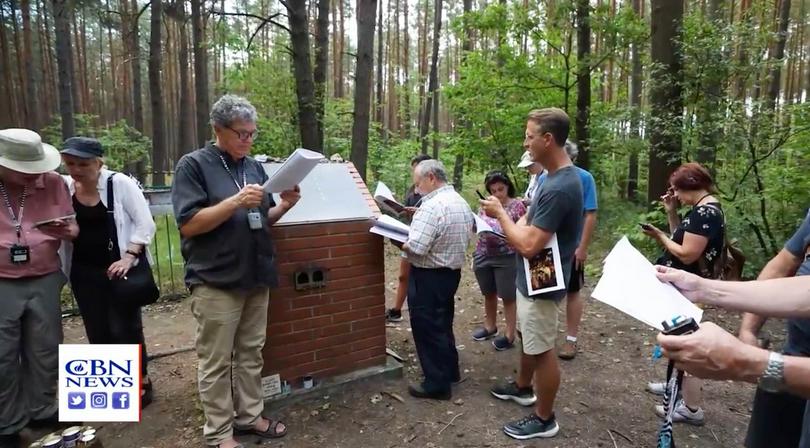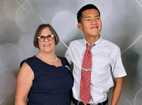WARSAW, TYKOCIN, Poland – Most people have heard about the horrors of the Holocaust although many don’t realize it ended a vibrant Jewish community in Poland, that had been in existence for a thousand years.
CBN News traveled to Poland to explore that history and its lessons for today on a unique tour called the Narrow Bridge.
“That's a phrase from a famous Hassidic (Jewish) folk song, and which goes ‘All the world is a narrow bridge. The main thing is not to be afraid,’” said Rev. David Pileggi who heads the Anglican Christ Church in Jerusalem.
“What has characterized life for Jews and Christians in this part of the world has been, especially in the last hundred years, is that life is quite risky and frightening and dangerous. And actually, it's a matter of life and death. And at the same time, we should not be afraid,” Pileggi told CBN News.
Each year he brings Christians from around the world here to explore the thousand-year history of the country’s Jewish people and the influence they still have today on Jewish communities around the world and the State of Israel.
“We come to this country to study Jewish life, Jewish-Christian relations, the Holocaust and in particular, I really want to ask the question, ‘Why did so many ordinary people do such horrible things?’ And at the same time, ‘Why did so many ordinary people do, such courageous things?’”
CBN News joined Pileggi and about 20 Christians from various backgrounds on his most recent tour.
“This is not your usual tourist trip of coming to Europe and seeing castles and gardens and pretty things. It's a little different. It's very different,” said attorney Raymond Dague, Chancellor of the Anglican Diocese of the Living Word, a tour participant.
Touching a remnant of the wall of the Warsaw Ghetto, standing on the dock where Jews would soon enter the Sobibor extermination camp, walking through woods along train tracks to the Treblinka death camp or visiting the deadly concentration camp at Madjanek – it was an eye-opening and heart-rending experience.
“This is about what happened to the Jewish community, a Jewish community in Poland that for a thousand years got along quite well with non-Jews. And then when World War II came was completely extinguished from this nation,” Dague told CBN News.
It includes stories of Jewish communities told in the cities and towns where they lived in eastern Poland like the story of Tykocin.
“We're standing in the city of Tykocin in northeast Poland and we're here next to the Narew River. We're in this town, as a group to discover why were Jews here in such large numbers. I mean we're in a very rural part of the world,” Pileggi told CBN News.
Invited here by the Polish nobility more than 800 years ago to help develop the country, these Jewish people thrived and by the eve of World War II had grown to 3-1/2 million – making the Jewish community in Poland the world’s largest.
“Many of the Polish aristocrats had estates in rural areas and Jews managed those estates, collected taxes for them, did any number of things, and ultimately helped the Polish aristocracy grow food and take that food up the Polish River system and to export it to different places around the world,” Pileggi explained.
But on September 1, 1939, World War II began and one of German leader Adolph Hitler’s aims was to rid the world of Jews.
In August 1941, in just one of thousands of cases, the Jews of Tykocin are brought to the town square and told they’re going to the ghetto in Bialystock. Instead, Nazis march or drive them out of town to a nearby forest.
There, the nazis murdered more than 2,400 Jews and buried them where they dropped. The community that had helped build Poland’s economy – wiped out in a day.
“It's very hard to look at the Holocaust and to think about the suffering people. I think one of the great things about this particular trip is that we're also studying the Jewish heritage sites. We're wanting to understand the Jewish community, the vibrancy of it in Poland before the war,” said another tour participant, Bible Translator, Brad H. Young, form the Hebrew Heritage Bible Society.
Thousands of these mass graves can be seen throughout central and eastern Europe. Even before the death camps or gas chambers, the shooting deaths of millions of Jews and others became known as the Holocaust by bullets.
At some of these sites, tour participants recited the Kaddish, the Jewish mourners’ prayer that proclaims the greatness of God.
Dague says the lesson he sees is how it could happen again.
“It's a frightening prospect. We all say to ourselves, ‘Oh, I would never do that. I could never be there.’ But, human nature is such that we have to be forever vigilant because these kinds of things can happen, and did, and did with a vengeance,” Dague cautioned.
There are also heroic stories, like the famous Oskar Schindler, who saved Jews by insisting he needed them to work in his factory that today houses a museum.
In Krakow, Tadeusz Pankiewicz owned a pharmacy in an area designated as the Jewish ghetto. As a non-Jew, he and his staff were supposed to leave but he fought to stay. They observed the Nazis rounding up the Jews, humiliating them, and shooting them.
Under penalty of death, they secretly tried to help sick and starving Jews and even hid some Jews in the pharmacy.
Young says it’s important to be in the place where things happened to fully understand the history.
“We must learn the history of the Jewish people and understand the connection that we have as Christians with the suffering of the Jewish people in history. Because there's a time now that we are seeking healing, reconciliation, knowing the real historical roots,” Young told CBN News.
Bishop Julian Dobbs, Bishop of the Anglican Diocese of the Living Word, a longtime student of Jewish history, says he came to Poland because so much of that history happened here.
“I believe that we understand our Christian faith more fully when we do so through a Hebraic lens, and therefore understanding the place of the Jewish people, both in our faith through the scriptures, but also in the history of the Jewish people before Jesus, before Yeshua, and after him deepens our understanding of our own faith journey,” Dobbs explained.
Pileggi says for years he taught people about the Jewishness of Jesus and the Jewish roots of Christianity, but it seemed artificial that interest in the Jewish people stopped when the New Testament was written.
“Of course, God still has his purposes for the Jewish people. He still remains in covenant with them. I think it's quite important that we have a basic understanding, of their history,” Pileggi added.
Originally from Webpage "CBN News"
CCD edited and reprinted with permission












